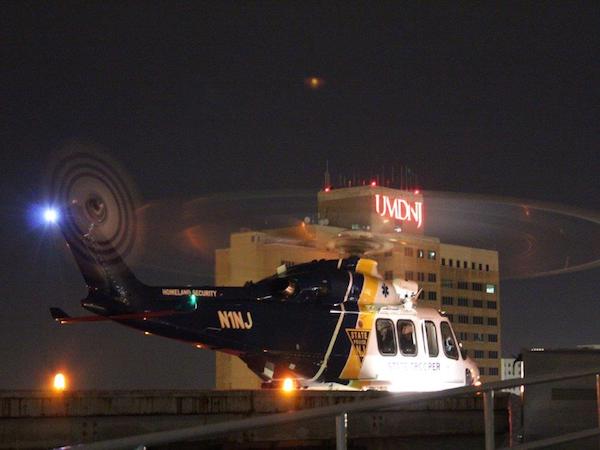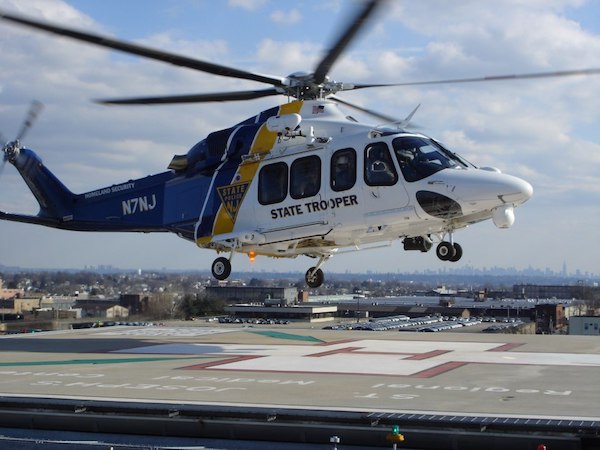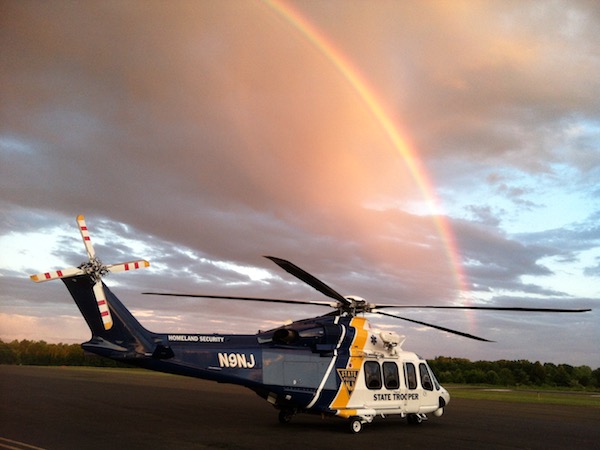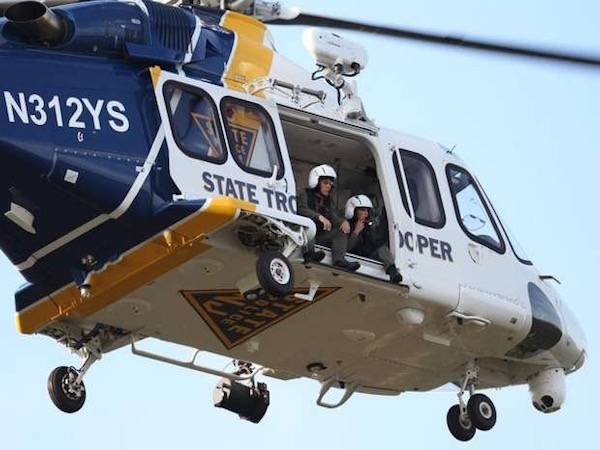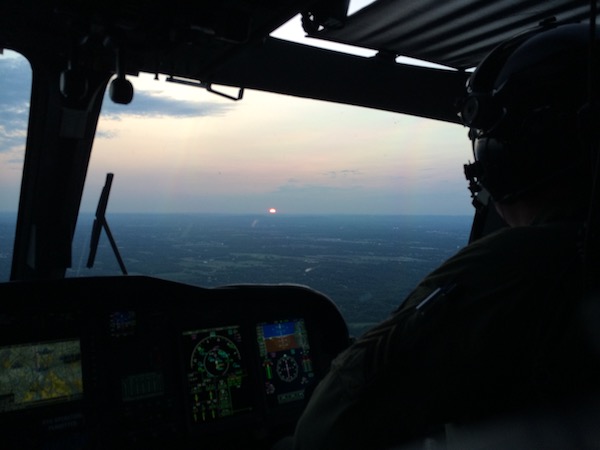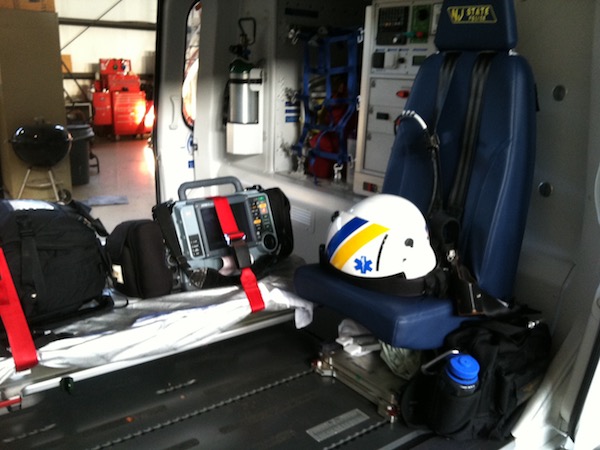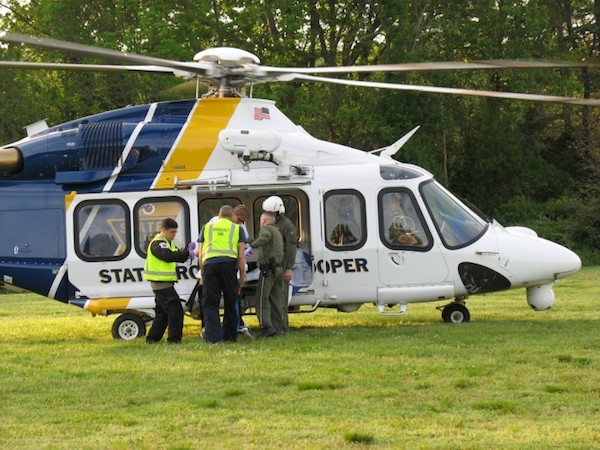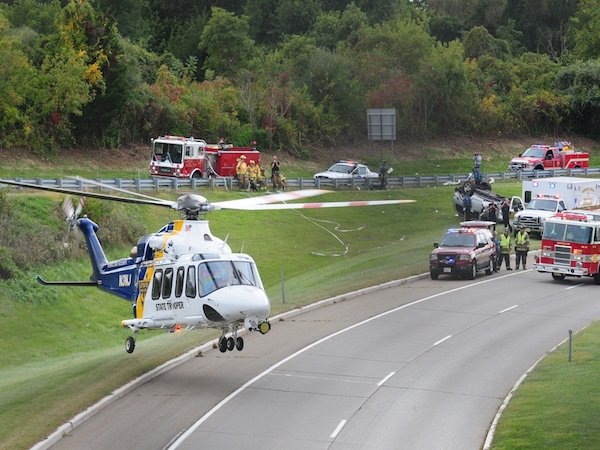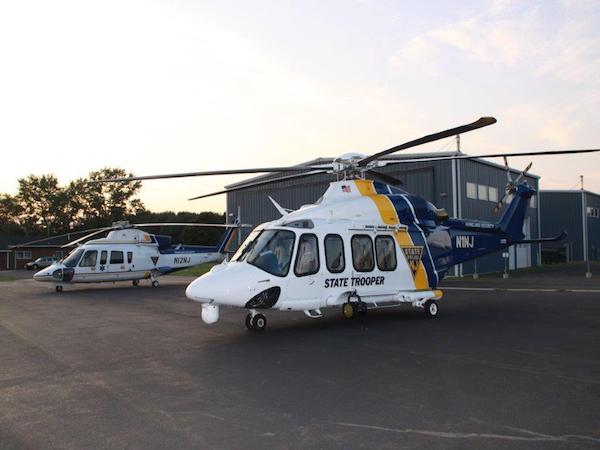University Hospital Emergency Medical Services
JEMSTAR
University Hospital EMS proudly staffs the medical component of the New Jersey JEMSTAR program, in conjunction with the New Jersey State Police and the New Jersey Department of Health. Operating from of a fleet of Agusta AW-139 medevac-equipped helicopters piloted and maintained by the New Jersey State Police Aviation Unit, a UH-EMS Flight Paramedic and Flight Nurse provide advanced life support care while in air transit to specialty centers. All of our medical flight personnel are highly-experienced ALS providers that have completed rigorous training in air-medical operations and advanced trauma life support.
JEMSTAR crews are strategically positioned across the state to respond to on-scene emergency responses and critical care interfacility transfers. They may also be requested to provide air support for search and rescue operations.
REMCS dispatches all JEMSTAR crews and provides flight-following.
NorthSTAR is based at Somerset Airport (KSMQ) in Bedminster, Somerset County, New Jersey.
SouthSTAR is based at Hammonton Municipal Airport (N81) in Hammonton, Atlantic County, New Jersey.
Air medical evacuation may be requested for any victim of an acute traumatic injury who requires advanced life support during transport to a trauma or burn center. A request for air medical evacuation may also be appropriate when the time of on-scene extrication and ground transport exceeds twenty minutes. (Please refer to the Adult Trauma Triage Protocol)
JEMSTAR may be requested by any public safety agency by contacting REMCS at 1-800-332-HELO. Please visit the guidelines sections of this website for more information on JEMSTAR dispatch criteria and safety.
Information & Dispatch Guidelines
Air medical transportation should be considered for all victims of acute trauma requiring advanced life support transportation to a trauma or burn center where the extrication and ground transport time would exceed twenty minutes. (External Link: Please refer to the Adult Trauma Triage Protocol)
A JEMSTAR crew may be requested by any public safety agency (Law Enforcement, EMS, Fire) by contacting REMCS at 1-800-332-HELO (4356). A specially trained air-medical dispatcher will assist with the request.
When contacting REMCS, the following information should be immediately available:
- Requesting Agency Name
- Contact Name and Phone
- Incident Location
- Type of Incident or Nature of Injury
- Number/Age of Victims
- Location of Landing Zone with Cross Streets
- Landing Zone Coordinates
- Contact Frequency/PL
- Agency Name or Unit of Landing Zone Coordinator
- Type of request "Stand-by" or "Go"
When JEMSTAR is requested, a request shall also be made for a ground MICU/ALS unit to respond.
REMCS serves as the dedicated air-medical communications center for New Jersey. All air-medical requests from all locations within the state must be directed to REMCS. Should a JEMSTAR aircraft be unable to accommodate the request, REMCS will attempt to arrange a local mutual-aid medevac unit to handle the request.
Weather Requirements
JEMSTAR crews abide by strict weather requirements to ensure the safety of the flight crew, aircraft, and patient. Weather requirements are based primarily on ceiling and visibility. Prior to each flight, the current conditions within the requested flight path will be reviewed by the New Jersey State Police pilots. While attempts are made to accommodate every request, the final discretion on accepting flights is based on safety and resides with the ranking New Jersey State Police pilot in charge.
Basic Weather Requirements for JEMSTAR Response:
- Day
- Minimum Visibility: 2 nautical miles
- Minimum Ceiling: 800 feet
- Night
- Minimum Visibility: 3 nautical miles
- Minimum Ceiling: 1000 feet
Landing Zone Requirements
- Landing Zones should be at least 110 feet by 110 feet, level, firm, dry, and free of debris
- Landing Zone approach should be free of any nearby obstructions (power lines, poles, trees, etc.)
- Landing Zone should be secured by law enforcement and clear of any vehicle or pedestrian traffic
- All personnel, vehicles, and apparatus should be kept at least 100 feet from the perimeter of the LZ
- The corners of the landing zone should be marked with brightly colored cones, lights, or vehicles
- Use of flares for marking landing zones is discouraged unless extreme care is used in their anchoring
- Halogen rotators or flashers on public safety vehicles are best for marking landing zones when possible. Excessive use of strobes or spotlights is discouraged.
- During wet or winter conditions, landing zones should be on paved or concrete surfaces and cleared of excess snow/ice if possible
- Landing zones not meeting these requirements or those appearing unsafe may be rejected by the pilots
Aircraft Safety Requirements
- NEVER SHINE LIGHTS AT AIRCRAFT. This includes spotlights, flashlights, strobes, and flash photography. This can distract and/or blind the pilots.
- NEVER APPROACH AIRCRAFT WHILE ROTORS ARE MOVING. A member of the JEMSTAR flight crew will escort all personnel to and from the aircraft when the rotors have completely stopped.
- NEVER APPROACH THE AIRCRAFT AT ANY TIME WITHOUT ESCORT OR BY INSTRUCTION OF FLIGHT CREW. The aircraft should only be approached with caution from either side in full view of the pilot. The rotors may move without warning and will cause serious bodily injury. Approaching from the rear is prohibited at all times.
- SMOKING IS PROHIBITED within 300 feet of the aircraft and perimeter of the landing zone.
- Safety glasses, helmets, and other available PPE should be worn at all times. Debris may be picked up and thrown by rotor wash. Extreme caution should be used in vicinity of landing zone.
- All loose items should be secured before approaching aircraft
- Arms and intravenous lines should never be raised above shoulder height
- All other instructions given by Flight Crew or State Police shall be followed
Public Outreach
The JEMSTAR Flight Crews routinely participate in public outreach programs to educate the public and public safety representatives about the program’s mission, history, request and dispatch guidelines, and safety.
The goals of the Public Outreach Programs are focused individually at three main audiences that interact with our program. Community Relations programs are developed to promote working relationships with schools, civic organizations, and groups by providing education on trauma prevention, safety, and the JEMSTAR medevac program.
Public Safety Relations programs focus on educating New Jersey's public safety and emergency services personnel on the JEMSTAR program, dispatch and requesting guidelines, landing zone information, and aircraft safety. This program may also include a tour of our medevac aircraft and increases awareness among Law Enforcement, Fire, and EMS agencies that may utilize on-scene responses of JEMSTAR.
Hospital Relations programs are focused on developing and maintaining strong inter-facility relationships to maintain a seamless continuity of care between sending facilities, JEMSTAR crews, and receiving facilities/trauma centers. JEMSTAR staff also present an orientation program to hospital physicians, nurses, and staff outlining requesting and transfer guidelines as well as aircraft safety and proper loading/unloading procedures.
JEMSTAR crews may also be requested to attend and participate in civic events, public safety drills, school and community mock-DUI demonstrations, and other special events. For more information regarding any of our outreach programs including scheduling tours of our medical aircraft please contact our JEMSTAR Outreach Team by clicking on the link below and filling out the online form:
Link: JEMSTAR Safety Outreach Program Request Form
Note: Requests will be reviewed on a first come, case-by-case basis and are contingent on availability of the flight crew and aircraft, weather, and other factors. A minimum of 60 days advance notice is requested to accomodate all requests.
Interfacility Critical Care
JEMSTAR may be requested by attending physicians for interfacility critical care transportation.
All critical care transfer requests should be directed to REMCS at 1-800-332-HELO (4356). A specially trained air-medical dispatcher will assist with the request.
When contacting REMCS, the following information should be immediately available:
- Requesting Hospital Name/Unit
- RN Contact Name and Phone
- Receiving Hospital Name/Unit
- Sending and Receiving Physician
- Patient Name, Age, and Diagnosis
- Specialty Treatment Requirements
- Location of Landing Zone with Cross Streets
- Landing Zone Coordinates
- Contact Frequency/PL
- Agency Name or Unit of Landing Zone Coordinator
Prior to accepting a critical care mission, the nurse or attending physician must provide a complete patient report to the on-duty JEMSTAR flight nurse, which will be accommodated through REMCS.
Prior to requesting JEMSTAR, arrangements must be made with the receiving facility through attending physician.
All weather, safety, and landing zone requirements for on-scene responses apply to critical care missions.

